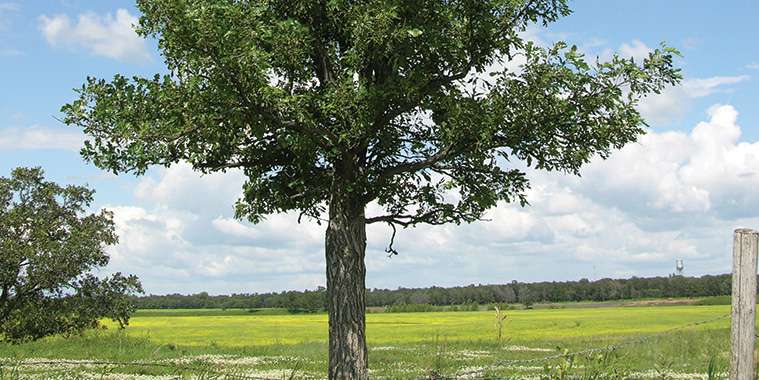By Dorothy Dobbie
A member of the white oak family, bur oak is native to the eastern prairies.
The tree develops tap roots when young, one of the reasons that it is hard to transplant large bur oak from nursery stock. It is recommended that transplanting of seedlings take place at one year. Bur oaks do well in well drained sandy or clay loam soils, where their early tap root can drill down to compete with prairie shrubs and grasses. In heavy clay soils, they will often lose their tap roots as they mature in favour of strong lateral roots that anchor them to the earth.
We take bur oaks for granted here in Manitoba, and often, as in my backyard, they are planted by friendly squirrels. But this majestic tree is under threat in Winnipeg where careless developers cut down centuries-old trees without any thought of the value they are destroying. The conditions of city living are hard for the trees, too, making them vulnerable to disease. Oak decline is being seen more and more as evidenced by dieback on topmost leaves and limbs.
If you have a bur oak, be sure to water it during droughts but drain away standing water. Mulch oak leaves in place to return nutrients to the soil (just run your lane mower over the fallen leaves).
A healthy bur oak can live up to 400 years, although most in Canada have a life span of about 200 years. Like all long-lived trees, bur oaks are slow growing. Acorn production may take a while: anywhere from 10 to 50 years! But at maturity the bur oak can be 80 feet tall with an equal spread. Grow bur oak in full sunlight and give it plenty of room to spread its limbs.
Sometimes bur oaks will be infested by galls, which are formed by gall wasps, midges, aphids and mites. The galls are obvious on tree branches and while they are unsightly, the tree is usually able to withstand their presence without damage to its overall health. The galls were once valued for the strong black dye they gave from which ink was made.
Bur oaks are fire tolerant, thanks to their thick, light gray to grey/brown, ridged bark. This species produces a large number of acorns, one to 1.5 inches long. The acorns are edible as long as the tannins are leached out by boiling or soaking them. They are full of iron and manganese and can be ground into flour or roasted.
The bur oak likes to live alone unless it is the company of other oaks. It does not do well in the shade of other large deciduous trees, so plant yours in the front yard away from the boulevard.
Oak are more often struck by lightning than many neighbouring trees, partly because of their height, but also due to the fact that their structure is conducive to electrical conduction. However, elms are also high on the lightning list.
The oak is a symbol of strength and durability. It has been held in great
esteem by the Greeks, Romans, Celts and Slavs. Roman commanders were presented with crowns of oak leaves to wear in victory parades. And even today, the oak leaf is a symbol of military prowess.
Oak bark has long been prized by leather tanners for the large number of tannins it contains. Its wood is even grained and honey-coloured, ideal for carving.
Planting one is not a bad message to send to the world about your own household!
Dorothy Dobbie is the publisher of Manitoba Gardener.



